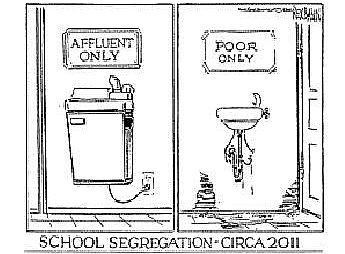Exploring the Implications of Standardized Testing on Wikipedia
by McKenzie Jones

This website presents information on the way education in America is presented on wikipedia and the problems with standardized testing. Standardized tests are present in nearly every level of American education, but I did not start to realize the issue with them until recently. I volunteer at a local after school mentoring program where I work with elementary school students from disadvantaged backgrounds to help them with reading and their homework. One of my mentees in particular stands out. Her name is Antoinique, and at ten years old, she is illiterate. Standardized testing is at the root of her lack of educational improvements. Richmond public schools struggle with funding; to maintain the already low level of funding, each teacher needs approximately 80% of their students must pass their Standards of Learning exams. So, students like Antoinique who have next to no chance of passing are often overlooked in favor of focusing on other students who will pass with the appropriate help. The students who pass move on to the next grade, and those who do not have to repeat the grade. Antoinique has been repeating the first grade for the past several years. Her mother works two jobs to make a living, so she is unable to spend much time with Antionique; she only has Youth Life to help her progress her education.

Me and my mentee, Antoinique.
A few attempts were necessary to pick the right topic for this website. First, school districts in Virginia were considered. However, there is not enough information on many of the schools’ wikipedia pages to make an interesting website. Next I looked at standardized testing in Virginia, and then more broadly in other areas of the US. This branched out to include legislation surrounding standardized testing, different examples of tests, their implications in the classroom, and school funding and some examples of teacher strikes in America. All of the information comes from the Wikipedia pages of the topics because for the purpose of this project, we are more interested in Wikipedia’s interpretation of each topic than the topic itself. The way that the topic is represented in the selected pages reflect my personal opinions, which is the intent. If a reader associates standardized testing with its negative impacts on students and resulting teacher strikes, then they may be swayed against them.
The pages are ordered in the way that I would have clustered the different page names. Surprisingly, the clusters created in the corpus did not exactly match what I designed. First, there are pages to introduce the general subject matter, including Education in the United States and Standardized Tests. Next are some examples of standardized tests in primary schools from some states including Virginia and North Carolina, and university entrance exams including the SAT and GRE. Then, some pages on the legislation surrounding education and standardized testing to look at how time periods and administrations have approached primary schooling. These pages include No Child Left Behind and Standards-Based Education Reform in the United States. I chose to also include Affirmative Action in the United States because of the segregation in the US that occurs due to the high concentration of minority groups living in impoverished areas. To help shed more light on this, I included pages titled School Segregation in the United States and Achievement gap in the United states. Finally, there are five pages on teacher strikes in North Carolina, West Virginia, Colorado, and other areas.

A political cartoon of modern segregation.
There are several interesting observations from the data. The pictures chosen to represent each page are interesting to look at. Most notably, some of the pages do not even have a picture to show for the documents page. For some of the smaller pages, like the standardized testing for specific states, it makes sense for there to not be a picture included. However, I was surprised to see that a large page, the List of Standardized Tests in the United States did not have a picture. Finally on that note, the pages that do not have a picture pulled for them do still have at least one image on the page. The highest measure of centrality is for SAT at .71. Most other pages are either close to .22 or at 0.
Let’s look at the changes over time in a few of the pages. The introductory paragraph on the SAT page in 2002 was a simple sentence to say that it is the best known college entrance test. One of the two sections at the time was titled Harsh Criticisms, which has since changed to the Perceptions section. Most recently in 2018, the paragraph gives a short history and notes that it is widely used in college admissions, but no longer the most popular test. The page titled Education in the United States has seen a lot of change over time. The important details that are always explained are that it is a decentralized system with states themselves deciding most of the legislation. Some years, not including the present, highlight that funding comes from the local, state, and federal levels in that order. Two of the most commonly used words in most years are private and public because there is a large difference between the two that must be highlighted. The changes in Affirmative Action are interesting as well, especially from before and after the Black Lives Matter movement, which peaked in 2015. One important distinction that is currently on the page that previously was not is these two sentences: “The impetus toward affirmative action is redressing the disadvantages associated with past and present discrimination. Further impetus is a desire to ensure public institutions … are more representative of the populations they serve.” I appreciate this sentiment, and hope to see it carried out in the near future.
One of the very few changes in names for the Wikipedia pages is the Achievement Gap in the United States page, which used to be simply called Achievement Gap. This is possibly because other countries began to see an educational achievement gap, and the distinction needed to be made. The state school page is translated into 23 different languages, which is one of the largest of the data set, and is of interest because it only deals with education in America. Of course, it also talks about US colleges, which many international students attend and there must be a large enough demand for multiple languages.
According to wikipedia itself, the sites are not written in any specific format . Essentially, it is in the order that it was added by the many wikipedia contributors. I would argue that this is not entirely accurate. While many of the introductory paragraphs seem to be changed at whim, the general message of them remains throughout the years, and they all say essentially the same thing. The structure and characteristics of the pages seem easily explainable and consistent across different pages. Longer pages that are likely more widely used generally have more images and are translated into more languages. For the most part, more images is positive correlated with more language pages. While the volunteer editors may pick and choose what to focus on, the structure of wikipedia pages is generally consistent. This is actually quite impressive to me because thousands of people work on the pages for free, and they all turn out looking more or less the same. The chosen wikipedia pages represent standardized testing in America well, and help a reader find the intended conclusions.